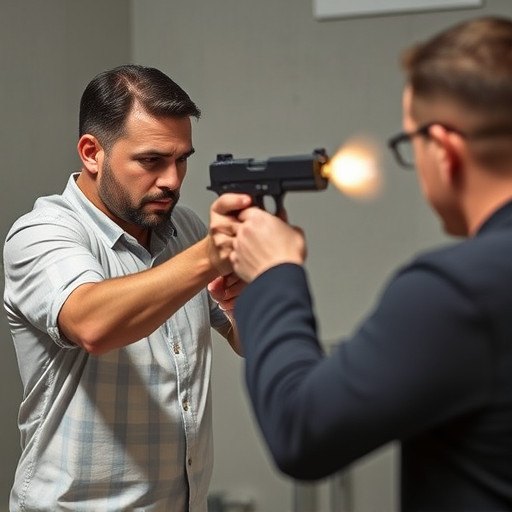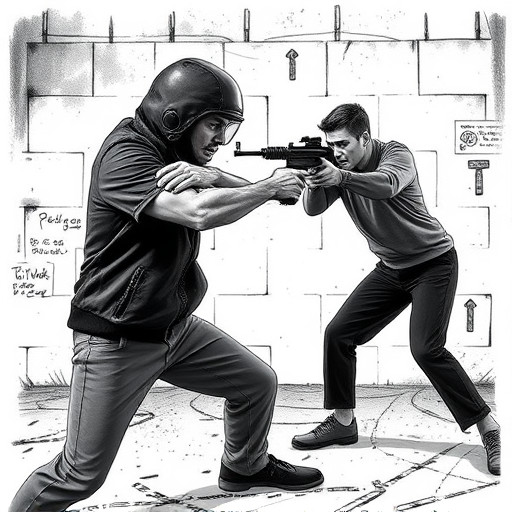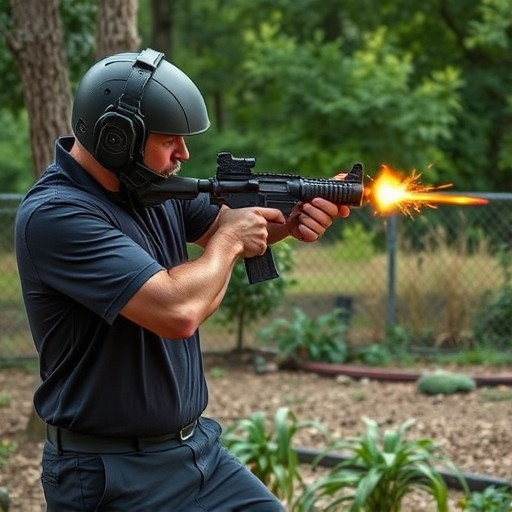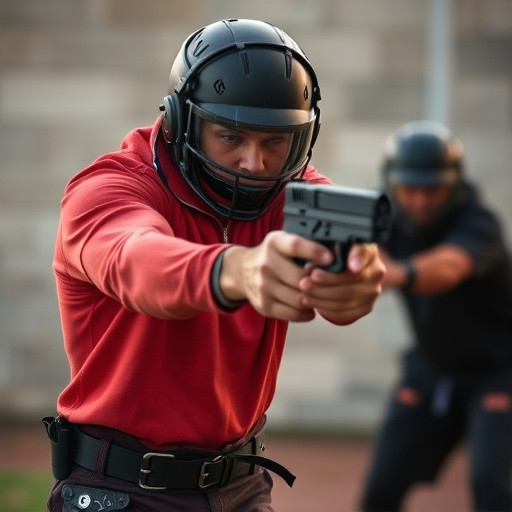Stun guns, while powerful tools for self-defense, pose risks of accidental discharge due to various factors. To prevent such incidents, understanding device mechanics and implementing safety measures is crucial. These include control circuits that deactivate improper triggers, regular cleaning and dryness maintenance, and safe handling practices. Active features like trigger disablers and sensor technology detect unintended movements or detachment, significantly reducing misfires. Passive methods, such as impact-resistant casings and secure locking mechanisms, further safeguard against accidental activation. User training, education, and regular maintenance protocols also minimize risks by promoting responsible use and ensuring optimal device performance. Advanced safety features powered by AI adapt to users' techniques and environmental conditions, enhancing reliability for personal protection while preventing accidental stun gun discharge.
In today’s world, personal safety is paramount. Stun guns, designed for self-defense, must be used responsibly. This article explores comprehensive strategies to prevent accidental stun gun discharges, focusing on understanding the mechanism and common misfires, active safety features like trigger disablers and sensor tech, passive methods through robust design and material choices, user training, regular maintenance, and advanced smart sensors with AI assistance. By implementing these measures, users can maximize safety while harnessing the power of stun guns effectively.
- Understanding Stun Gun Mechanism and Common Misfires
- Active Safety Features: Trigger Disablers and Sensor Technology
- Passive Prevention Methods: Robust Design and Material Choices
- User Training and Education for Responsible Stun Gun Use
- Regular Maintenance and Testing Protocols for Reliable Performance
- Advanced Safety Features: Smart Sensors and AI-Assisted Response
Understanding Stun Gun Mechanism and Common Misfires

Stun guns, also known as electronic control devices (ECDs), operate by delivering a high-voltage, low-current electrical pulse to disrupt an opponent’s neuromuscular function, causing temporary incapacitation. This is achieved through a combination of circuitry and electrodes designed to generate and emit the shock. However, despite their reliability in controlled scenarios, stun guns are prone to accidental discharges, or misfires, which can have dangerous consequences. Common misfire causes include sudden movements, pressure on the trigger, or contact with wet or conductive surfaces, leading to unintended activation.
Preventing accidental stun gun discharge is paramount for both users and bystanders. Understanding the device’s mechanism and common misfire triggers is a crucial first step. Users should familiarize themselves with their stun guns’ safety features, such as built-in control circuits that deactivate the device when triggered improperly. Regular maintenance, including keeping the device dry and clean, and ensuring proper storage, can also significantly reduce misfires. Additionally, training in safe handling practices, like never pointing the device at anything other than the intended target, is essential for minimizing accidental shocks.
Active Safety Features: Trigger Disablers and Sensor Technology

Stun guns, while powerful self-defense tools, require meticulous design to prevent accidental discharge, ensuring user safety and intended functionality. Active safety features play a pivotal role in this regard, with two primary mechanisms gaining prominence: trigger disablers and sensor technology. Trigger disablers are designed to prevent unintended activation by requiring a specific motion or pressure, such as a firm squeeze or dual-trigger mechanism, minimizing the risk of accidental discharge during handling or unexpected movement.
Sensor technology takes this a step further, incorporating advanced sensors that detect body movements and proximity. These sensors can intelligentize the stun gun’s response, deactivating it if it detects an unexpected movement away from the target or if the device is dropped. This ensures that the stun gun remains inoperative unless intended by the user, significantly reducing the chances of preventing accidental stun gun discharge.
Passive Prevention Methods: Robust Design and Material Choices

In the pursuit of preventing accidental stun gun discharge, passive prevention methods play a crucial role through robust design and material choices. Manufacturers often incorporate features like impact-resistant casings, which not only shield the device from external damage but also reduce the likelihood of unintended activation. Additionally, these designs include secure locking mechanisms that prevent accidental release, ensuring the stun gun remains inactive until deliberately activated by the user.
The selection of durable and high-quality materials is another strategic step in mitigating misfires. Components made from robust metals and advanced polymers can withstand rigorous handling while maintaining precise control over internal mechanisms. This ensures that environmental factors like moisture or extreme temperatures do not compromise the device’s functionality, thereby further safeguarding against accidental discharge.
User Training and Education for Responsible Stun Gun Use

User Training and Education are essential aspects of responsible stun gun use, as they play a pivotal role in preventing accidental discharges. When individuals receive proper training, they gain a comprehensive understanding of their device’s functionality, safety mechanisms, and appropriate deployment scenarios. This knowledge empowers users to handle their stun guns with confidence while minimizing the risk of unintended activation.
Educational programs often include detailed instructions on safe storage, triggering techniques, and awareness of surrounding environments. By learning about the various safety features like trigger locks, tactical switches, and sensitivity settings, users can adapt their handling practices accordingly. Such training encourages responsible ownership, ensuring that stun guns are only deployed in genuine self-defense situations, thereby reducing the chances of accidental misfires.
Regular Maintenance and Testing Protocols for Reliable Performance

Regular maintenance and testing protocols are essential for ensuring stun guns operate reliably, preventing accidental discharges. Users should establish a routine for inspecting their devices, checking battery health, and lubricating moving parts to maintain optimal performance. This proactive approach significantly reduces the risk of an unintended activation, which could be dangerous or even fatal in certain situations.
Testing involves regularly simulating trigger pulls to ensure proper mechanism functionality. Many stun guns have safety features designed to prevent accidental discharge, but these mechanisms can fail over time or due to adverse conditions. Regular testing allows users to verify these safety protocols remain effective, enhancing personal security and peace of mind when relying on the device in emergency scenarios.
Advanced Safety Features: Smart Sensors and AI-Assisted Response

Advanced Safety features play a pivotal role in stun guns, particularly in preventing accidental discharge. Smart sensors are at the forefront of this technology, designed to detect precise movements and intentions. These sensors can differentiate between a deliberate trigger pull and an unexpected jostle, minimizing misfires. For instance, some models employ motion sensors that activate the device only when the user is in close proximity, ensuring it remains inactive during storage or accidental touches.
Artificial Intelligence (AI) further enhances safety measures by analyzing patterns of use and user behavior. AI algorithms can learn and adapt to individual users’ handling techniques, improving responsiveness and reducing false alarms. This technology also allows for smart safety protocols that adjust settings based on environmental conditions, ensuring optimal performance without compromising user safety. By combining these intelligent systems, stun guns offer a robust defense against accidental discharge, making them safer and more reliable tools for personal protection.
Preventing accidental stun gun discharge is paramount for safe and responsible usage. By understanding the mechanisms behind misfires, implementing active safety features like trigger disablers and sensor technology, adopting robust design principles, and ensuring proper user training and regular maintenance, we can significantly minimize risks. Additionally, advanced safety features such as smart sensors and AI-assisted response systems offer even greater protection. Embracing these comprehensive measures ensures that stun guns are used effectively while safeguarding users and those around them from accidental discharges.
